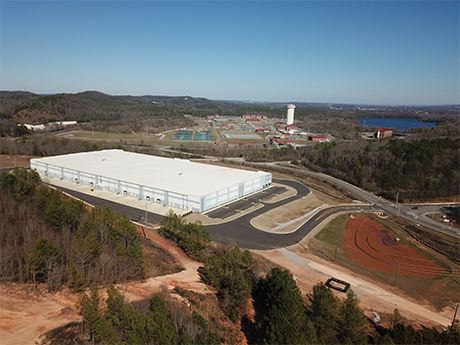By Henry Graham of Graham & Co.
As a reminder to those who may have missed my colleague Sonny Culp’s article from last year, 2021 and 2022 saw the delivery of more than 10 sizable build-to-suits to the Birmingham/Central Alabama region. Such rapid growth in the industrial sector grabbed the attention of larger industrial developers that have generally allowed Birmingham to fly under the radar.
Case-in-point, in the years from 2008 through 2016, the greater Birmingham metropolitan area was essentially devoid of any speculative industrial development. Instead, the pipeline of industrial projects was centered around owner-occupied spaces and the occasional build-to-suit related to the automotive sector or light manufacturing.

On the tailwinds of the recent build-to-suit frenzy and COVID-fueled supply demands, Birmingham experienced a flurry of speculative activity in 2022 and 2023 as regional and even national developers like Scannell Properties tested the waters alongside Alabama-based industrial developers.
Along a half-mile stretch of Daniel Payne Industrial Boulevard that sits just north of the central business district (CBD) and not far from the intersection of I-65 and I-20/59, four Class A spec buildings came up in rapid succession totaling 737,000 square feet. Two of those buildings are now fully leased with longer-term leases to tenants such as The Home Depot and Utz Quality Foods; the other two buildings have 305,000 square feet of vacancy eight months after shell completion.
Following our compass from the northern submarket to the east side of town, the I-20 corridor leading into Birmingham did not see any major construction projects during the calendar year of 2023, primarily due to general site scarcity and challenging topography within the submarket. The master-planned Kelly Creek Commerce Park remains the obvious landing site for any future large-scale industrial project looking at the Birmingham or Central Alabama area as the park has a completed access road and planned infrastructure to accommodate more than 1.5 million square feet of new projects with easy access onto I-20 at the Moody, Ala., exit.
Continuing our compass turn to the southern submarket, we didn’t see any new speculative projects come out of the ground in 2023, but we did see 108,000 square feet of vacancy filled in a semi-speculative building that delivered in late-December 2022. More troubling than the lack of new construction activity in the southern submarket was the abundance of second- and third-generation space that came back to the market from a combination of rollover and subleasing activity.
Rounding out our quick spin around the city, we turn our attention last to the western side of Birmingham/Jefferson County. While this area of Birmingham has proved a popular destination for some of the larger build-to-suit and industrial projects of recent years, we have witnessed two smaller build-to-suit projects totaling roughly 347,000 square feet sit vacant on the sublease market for more than a year because the original tenants (one being Amazon) elected not to occupy the space but instead pay rent and operating expenses on empty buildings.
One of these unoccupied build-to-suits recently traded hands in an off-market sale, and the subleasing scenario at the building offers a prospective tenant the opportunity to lease first-generation, Class A space for more than $1.25 cheaper on a per-square-foot basis than asking rents of spec warehouse that delivered in 2023. As the 2024 calendar year rolls into the second quarter, the asking rent on new spec industrial space around the city remains at historical highs (roughly $7.25 per square foot), and final base rents in leases tend to creep even higher with the current market pricing on turn-key tenant improvement packages.
In summary, the Birmingham industrial market continues to play catch up to the majority of its peer cities around the Southeast in regard to absorption of new Class A industrial space. The Magic City has always been a tricky market when it comes to finding balance as we always tend to be a bit underbuilt or overbuilt to meet demand at any given time.
Let’s hope that the second half of 2024 brings a few more deals to absorb the vacancy and return some balance to the market. It’s certainly not a fun time to be carrying empty buildings on the books.
— By Henry Graham, president and chief development officer, Graham & Co. This article was originally published in the April 2024 issue of Southeast Real Estate Business.


